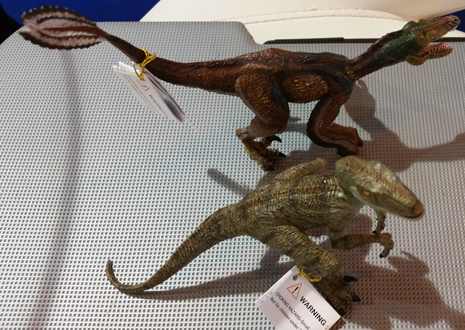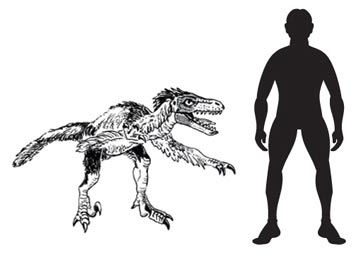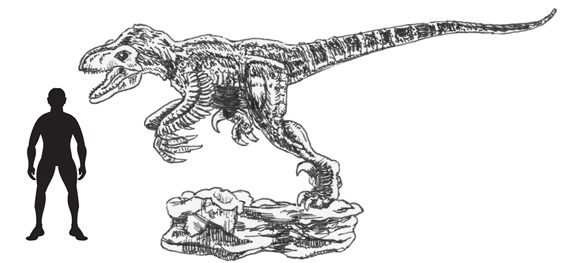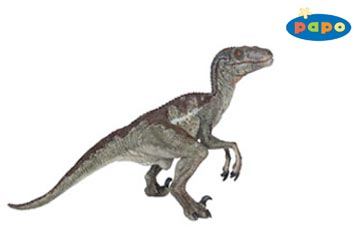Jurassic June – Jurassic World and the Velociraptors
Velociraptors Depicted as Pack Hunters in the Jurassic Park Franchise
As we build up to the premier of the eagerly awaited “Jurassic World” movie, the fourth in the “Jurassic Park” franchise, team members at Everything Dinosaur have been writing a series of articles about the prehistoric animals that feature. Today, we look at a dinosaur that has appeared in all of the films under the “Jurassic Park” brand, the fearsome, formidable Velociraptor.
Involved in all Four Movies – Velociraptor
Picture credit: Everything Dinosaur
Jurassic World and Velociraptors
It has been a few years since team members read the original “Jurassic Park” novel, but Velociraptors do feature in the book. They are depicted as intelligent, cunning and very dangerous pack hunters, themes which have run consistently through all the movies and in “Jurassic World”, the character Owen Grady, played by Chris Pratt has three trained Velociraptors. Owen regards himself as the “alpha member” of this Velociraptor pack.
However, two big criticisms have been put forward concerning the way the “raptors” are depicted:
- They are far to big to be Velociraptors
- They don’t have feathers
Let’s briefly deal with these in turn.
Size is Important
The genus Velociraptor currently consists of two species, both of which come from Asia. Within the Everything Dinosaur database, we cite Velociraptor fossil material coming from Mongolia, China (Inner Mongolia) and Russia. Although the classification of the subfamily known as the Velociraptorinae remains fluid with several revisions having been made to dinosaurs regarded as the “raptors” the dromaeosaurids, in the last decade or so, the raptors in the film and in the original book, written by Michael Crichton, are all referred to as Velociraptors.
These animals are depicted as six-foot-tall dinosaurs. In reality, this is much bigger than either V. mongoliensis or the more recently described Velociraptor osmolskae.
A Scale Drawing Showing Velociraptor mongoliensis Compared to an Adult Man
Picture credit: Everything Dinosaur
In the novel, first published in 1990, one of the lead geneticists Dr Henry Wu, a character played by B.D. Wong, in the movie franchise, states that the Velociraptors were created using DNA extracted from amber discovered in Mongolia. So far so good, but at the time of writing, Michael Crichton would have been aware of the size ranges given for Velociraptors in academic journals, after all, the first scientific description of V. mongoliensis took place in 1924.
The Velociraptor Genus
Velociraptor was certainly not as big as depicted in the films. It stood around one metre high and it would have been perhaps 1.8 metres to 2.3 metres long, perhaps a fraction longer. Most of its body length was made up of that long, straight tail supported by a network of tendons. Body mass estimates do vary, but a maximum weight of around twenty-five kilogrammes is often cited. We at Everything Dinosaur tend to air on the more cautious side of the debate, stating a body weight of around fifteen kilos. That is much lighter than an emu for example, think of a Velociraptor being as heavy as three domestic geese.
Knowing this, you can understand if film executives ended up subjecting Velociraptor to some “Hollywood growth hormones” to make the dinosaurs a little more scary.
Writing the Book/Researching the Characters
The research undertaken by the highly talented Gregory S. Paul is often stated as a reference source for Michael Crichton when he was researching his dinosaur characters. As Michael prepared to write his book, he may have come across references to a potentially, much larger “raptor” from Mongolia discovered by a joint Mongolian/Russian expedition in 1989 which set out to explore vertebrate fossils in the Upper Cretaceous Bayan Shireh Formation located in south-east Mongolia (Dornogovi Province). These fossils were scientifically described in 1999, after the book had been published and the films “Jurassic Park” and the sequel “The Lost World” had been released in cinemas.
The fossils represent a very big dromaeosaurid dinosaur. It has been named Achillobator giganticus and at around five metres long it represents the biggest “raptor” found to date in Asia.
An Illustration of a Large Dromaeosaurid Dinosaur Like Achillobator
Picture credit: Everything Dinosaur
So there were certainly some very large, dromaeosaurid dinosaurs about, several species more than six foot tall.
Jurassic World and Velociraptors
No Feathers
Although the evolutionary relationship between meat-eating dinosaurs and birds has been debated for over 140 years, at the time of writing “Jurassic Park”, very little fossil evidence had been put forward that added weight to the feathered dinosaur theory. The first papers detailing proto-feathers and quills were published in the late 1980s but it was not until the rich fossil finds of Liaoning Province in China began to be much more widely publicised that feathers in dinosaurs came to wider public attention.
A number of feathered dinosaurs are known, the majority of them meat-eating theropods. It had been thought that only the lizard-hipped Theropoda, those dinosaurs that were more closely related to birds had feathers. Recent discoveries, have challenged this theory and feathers have been identified in ornithischian (bird-hipped dinosaurs) too.
To read about a recent discovery of a feathered, bird-hipped dinosaur: Kulindadromeus – Did All Dinosaur Have Feathers?
Dromaeosaurid Dinosaurs with Feathers
The first dromaeosaurid dinosaur described with feathers was Sinornithosaurus millenii which was named and described in 1999, nine years after “Jurassic Park” was first published and two years after the film sequel “The Lost World” had been released. As Velociraptor fossils are associated with coarse and medium grained sandstones, feather preservation may not have been possible in this substrate. No feathered Velociraptor specimens have ever been found. Feathers in the Velociraptorinae subfamily are inferred as related dromaeosaurid dinosaurs are known to have possessed feathers.
Forgiving the Film Makers
What we can say about the Velociraptors depicted in the book and the subsequent films, is that they are seen as social, pack animals, which are very agile and fearsome predators. The fossil evidence uncovered so far certainly supports this. Fossilised tracks suggest pack behaviour in these types of dinosaur to read about this: “Raptor” Tracks Indicate Pack Behaviour.
Our knowledge of these types of dinosaurs is growing all the time.
To read about a newly described (May 2015) species of North American dromaeosaur: Saurornitholestes sullivani – Sniffing Out a New Dinosaur Species.
Can we recommend top quality Velociraptor models for dinosaur fans? Check out the Velociraptor models here: Beasts of the Mesozoic Articulated Dinosaur Models.
Similar to the Velociraptors Seen in the Movies
Picture credit: Everything Dinosaur
To view the Papo model range including dinosaur figures: Papo Prehistoric Animal Models.





